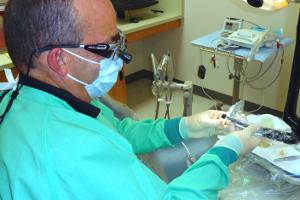Listen to the QUEST radio story Visiting the Dentist Chair of the Future.
“So you don’t feel vibration. Yes, you hear the sound, you hear the tck tck tck, but that’s it,” says Rechmann. That makes a big difference, especially when Rechmann is working with younger patients. “Kids typically fear things more than adults. And they don’t care, they like it. Sometimes they say, ‘Oh, that was interesting’.”
Lasers have been used in dentistry for about a decade, but mostly on soft tissues like gums. Rechmann says laser drills are becoming more common now that the cost is coming down. And he expects lasers to soon play an even bigger role by actually helping to prevent cavities.
Rechmann holds a pulled tooth and fires short laser pulses at a small area on the outside. “The temperature on the enameled surface gets heated up to between 400 and 1000 degrees Celsius. It sounds terrible but it’s not. It’s really just the outer surface,” he says.
The extreme temperature slightly alters the make up of the outer tooth enamel which, Rechmann says, makes it more resistant to tooth decay. They’re now testing the treatment in clinical trials and it could be available in one to three years.
“If you treat this once, OK, you should still keep on brushing your teeth, but it’s really strongly protecting your teeth,” says Rechmann.
Of course, what our teeth really need protection from are our own bacteria. They’re specially adapted to live in our mouth, which, with all the food we chew, is a pretty nice place to call home.
“It’s a very nice place. It’s nice and warm and comfortable,” says John Featherstone, Dean of the UCSF School of Dentistry.
“Bacteria produce acid – that’s their major waste product. And that acid dissolves the enamel in the teeth.” Featherstone says in the past, dentistry has been focused on cleaning up the damage done by these bacteria. Now, he also sees the field moving towards prevention.
“If we can diagnose as we can now early on, what it tells us is that there’s disease process going on and we have to halt the disease process,” says Featherstone.
But given our teeth brushing habits - or lack thereof - Featherstone says there will probably always be a need to fill cavities. But what if cavities could fill themselves?
Self-Filling Cavities
Stefan Habelitz is standing in front of a refrigerator that holds 20,000 pulled teeth, collected from local dental clinics. Habelitz is a material scientist. He studies the structure of teeth.
“It’s amazing, a really amazing structure. For an engineer, it’s a real feast,” says Habelitz.
Tooth enamel is the hardest substance in our body. It’s designed to break apart foods like seeds or hard candy. “But if it can’t, it will release stress by forming fractures, by forming cracks,” Habelitz says.
Those tiny cracks are actually good -- they’re part of the tooth’s design. They prevent it from being broken by one big crack. The problem with our teeth, Habelitz says, is that unlike our bones or skin, we can’t regrow tooth enamel. At least, not by ourselves.
“So let’s just drop these teeth in here.” Habelitz takes a few teeth with very large cavities and drops them into a beaker filled with a special solution. Tooth enamel is made of a mineral - so Habelitz says it’s not too difficult to remineralize or rebuild the enamel. That’s something the fluoride in toothpaste helps do.
“But once the bacteria makes it through the enamel, then it has been so far impossible to remineralize these legions,” says Habelitz.
That’s because deeper in the tooth in the material called dentin, minerals are mixed with organic structures, which are much harder to regrow. What Habelitz has in this beaker is a special compound that regrows the minerals and bonds them to the organic structures.
“So only when that link is established, the tissue that you build up again actually will be strong enough and stiff enough to support the pressure that you apply when you chew on your teeth,” he says.
One day, Habelitz says this process could be done right inside a patient’s mouth. The problem now is the process takes a long time -- several weeks to fill a small cavity. “It should be an approach that needs to be done at least within a day, ideally within a few minutes.”
Habelitz is working to speed up the process, though it will be years before it’s available. But even if he and his colleagues can only regrow a small amount of a tooth, that’s part of a tooth that doesn’t have to be filled.
37.7634259 -122.4586312

